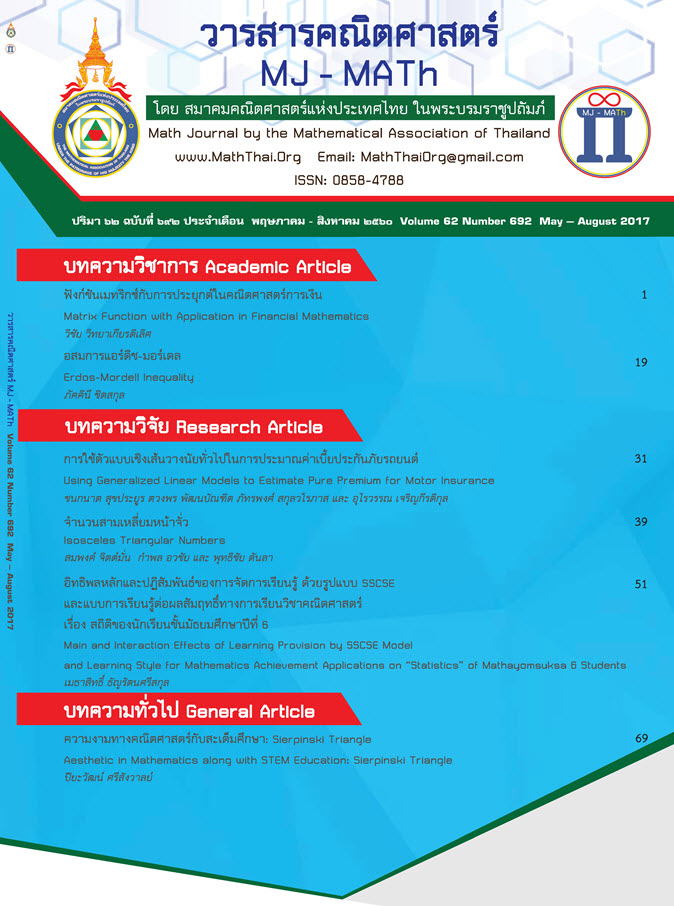Using Generalized Linear Models to Estimate Pure Premium for Motor Insurance
Main Article Content
Abstract
In casualty business, the optimal premium pricing and adequate cost for an insurance company is important in risk management. The aim of this research was to study in the application of generalized linear models to estimate pure premium for motor insurance. In this study, the data set was the claim of comprehensive motor insurance, which was provided by one of the insurance company in Thailand. The results of this study show that the risk factors significantly related to pure premium at the 0.05 level consisted of no claim bonus (NCB) and use of motor vehicle (Car Code).
Article Details
How to Cite
Sukprayoon, C., Pattanabandit, T., Sakulwaropas, P., & Jaroengeratikun, U. (2018). Using Generalized Linear Models to Estimate Pure Premium for Motor Insurance. Mathematical Journal by The Mathematical Association of Thailand Under The Patronage of His Majesty The King, 62(692), 31–38. retrieved from https://ph02.tci-thaijo.org/index.php/MJMATh/article/view/157369
Section
Research Article
References
[1] D. W. Hosmer and S. Lemeshow, Applied Logistic Regression, United States: John Wiley & Sons Inc., 2000.
[2] E. Ohlsson and B. Johansson, Non-Life Insurance Pricing with Generalized Linear Models, Springer-Verlag Berlin Heidelberg, 2010.
[3] J. Lemaire, Automobile Insurance: Actuarial Models, Dordrecht, Netherlands: Kluwer Academic, 1985.
[4] Joseph M. Hilbe, Negative Binomial Regression, 2nd ed. Cambridge, Cambridge University Press, 2011.
[5] M. David, “Auto Insurance Premium Calculation Using Generalized Linear Models,” Procedia Economics and Finance, vol. 20, pp. 147-156, 2015
[6] P. Jong and G. Z. Heller, Generalized Linear Models for Insurance Data, Cambridge, Cambridge University Press, 2008.
[7] P. McCullagh and J. A. Nelder, Generalized Linear Models, 2nd ed. London, United States: John CRC Press, 1989.
[8] R. Kaas, M. Goovaerts, J. Dhaene and M. Denuit, Modern Actuarial Risk Theory: Using R, 2nd ed. Springer, Berlin, 2009.
[2] E. Ohlsson and B. Johansson, Non-Life Insurance Pricing with Generalized Linear Models, Springer-Verlag Berlin Heidelberg, 2010.
[3] J. Lemaire, Automobile Insurance: Actuarial Models, Dordrecht, Netherlands: Kluwer Academic, 1985.
[4] Joseph M. Hilbe, Negative Binomial Regression, 2nd ed. Cambridge, Cambridge University Press, 2011.
[5] M. David, “Auto Insurance Premium Calculation Using Generalized Linear Models,” Procedia Economics and Finance, vol. 20, pp. 147-156, 2015
[6] P. Jong and G. Z. Heller, Generalized Linear Models for Insurance Data, Cambridge, Cambridge University Press, 2008.
[7] P. McCullagh and J. A. Nelder, Generalized Linear Models, 2nd ed. London, United States: John CRC Press, 1989.
[8] R. Kaas, M. Goovaerts, J. Dhaene and M. Denuit, Modern Actuarial Risk Theory: Using R, 2nd ed. Springer, Berlin, 2009.


